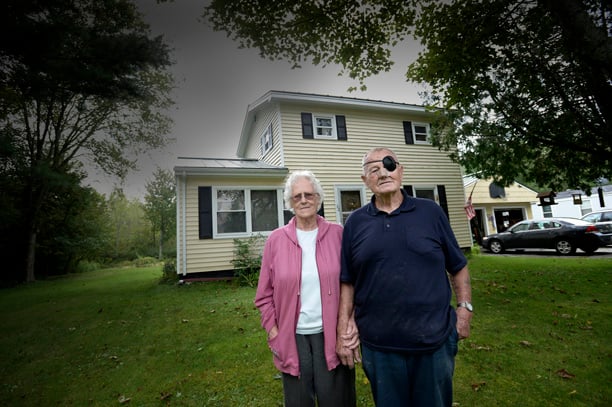PART IX: Hospice | October 19, 2014
Red flags? Maine hospice measures fall below national averages
The risk of loving Medicare funding or certification helps to counter the potential for waste, fraud and abuse, officials say.
Barbara DeWaters received such good care from Hospice of Southern Maine, some family members thought it was better than end-of-life care they had
experienced elsewhere.
Rick DeWaters’ wife compared his mother’s care to the hospice services her father received a few years ago in New York.
“She asked me, ‘Why didn’t we get all these services?’ ” said Rick DeWaters, the oldest of Barbara DeWaters’ five children. “I really don’t know. I think a
lot might have to do with awareness. You have to look into it and find out what’s available.”
Unfortunately, there’s no easy way to select a hospice agency, and ensuring quality end-of-life care requires consumers to be effective and knowledgeable
advocates for their own interests, as they would when purchasing any services.
As demand and use of Medicare-funded hospice programs skyrocket, so does the potential for waste, fraud and abuse that was exposed in recent national news
reports. But it may be difficult for consumers to choose among various nonprofit and for-profit hospice providers, especially amid the confusion and worry
that often follow a terminal diagnosis.
The Centers for Medicare & Medicaid Services requires certified hospice providers to explain all available services and deliver them as necessary
according to a doctor-approved care plan, including bereavement counseling for loved ones after a patient dies.
If they fail to offer or provide services as required, hospice agencies risk losing Medicare funding or certification. Problems can range from failing to
offer chaplain services to enrolling patients who aren’t dying in order to collect the $155-a-day hospice fees.
Some say there’s no cause for alarm in Maine. Kandyce Powell, head of the Maine Hospice Council & Center for End-of-Life Care, said there’s little
potential for widespread waste, fraud or abuse here because Maine has relatively few hospice providers – 19 Medicare-certified and seven volunteer programs
– and because state inspectors monitor them closely.
Indeed, Maine falls below the national average on several Medicare hospice measures that can flag problems, including length of care (62 days in Maine vs.
71 days in the U.S.), payment per beneficiary ($10,075 in Maine vs. $11,842 in the U.S.) and percentage of patients discharged alive (10.9 in Maine vs. 13
in the U.S.), according to Medicare data compiled by Hospice Analytics.
The Centers for Medicare & Medicaid Services and the Maine Department of Health and Human Services monitor hospice providers with regular certification
surveys, which Congress decided in September should happen every three years instead of every 6.5 years. But it’s unclear whether CMS will be able to
increase oversight that has been flagging for decades.
A 2013 study by the federal DHHS’s Office of the Inspector General found hospice agencies in several states that hadn’t been surveyed in more than a decade
and at least one agency that operated for 22 years without a survey.
Maine was ahead of the curve as one of the first states to adopt licensing regulations that require inspections every two or three years. Like Medicare
certification surveys, licensing inspections review hospice records to make sure that employees are properly screened and trained, and that services are
provided and documented to meet Medicare standards.
But these reviews have a limited scope and the resulting reports can be misleading and confusing, largely because they tend to focus on an agency’s
attention to paperwork and policy guidelines rather than what happens in the field.
Most hospice agencies in Maine have been cited for deficiencies at one time or another in the last decade, according to state and federal reports provided
to the Portland Press Herald/Maine Sunday Telegram under Freedom of Access Act requests.
Typical deficiencies included an agency’s failure to document criminal background checks on employees; a social worker’s substitution of a phone call for a
home visit; and a hospice aide missing multiple home visits altogether. In many cases, however, it’s unclear whether a policy or patient’s need wasn’t met
or simply wasn’t documented.
After deficiencies are found, an agency must submit a correction plan that wins the inspector’s approval in order to be relicensed or recertified, said
Tammy Steuber, paralegal at the state’s licensing division.
The process might not sound sufficiently punitive, but most agencies take it very seriously because they could be forced to return Medicare payments for
disputed services or lose their certification.
“Whenever we have deficiencies, they are taken seriously and acted on immediately” said Elaine Brady, a founder, board member and former interim executive
director of Hospice of Southern Maine.
Part IX: Hospice
Someone to watch over THE JOURNEY’S END
End-of-life care gave 92-year-old Barbara DeWaters the freedom to meet her death with dignity, surrounded by loved ones in a place she cherished. Will aging Mainers like her get the same medical and emotional support as demand for Medicare-funded hospice services skyrockets?

Part IX: Hospice
Hospice movement grows beyond Maine’s urban areas
As Sussman House prepares to open in Rockport, providing close-to-home end-of-life care to Midcoast residents, two more projects are in development, one near Bangor and another in Aroostook County.

Further Discussion
Here at
PressHerald.com we value our readers and are committed to growing our community by encouraging you to add to the discussion.
To ensure conscientious dialogue we have implemented a strict no-bullying policy. To participate, you must follow our
Terms of Use.
Questions about the article? Add them below and we’ll try to answer them or do a follow-up post as soon as we can.
Technical problems? Email them to us with an exact description of the problem. Make sure to include:
- Type of computer or mobile device your are using
- Exact operating system and browser you are viewing the site on (TIP: You can easily determine your operating system here.)







